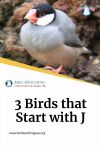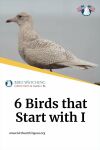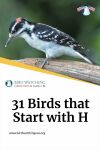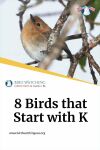
Introduction
Hey there, bird lover! Can you think of a bird that begins with the letter K? Another twist: it has to be among the 750 most common birds in the USA and Canada. Don’t panic if you can’t think of any because I’ve got you covered. There are only 8 such birds and that means it’s only 1.06% of the total!
Perhaps you might aready know about some of them. But if you’re like me, there’s always room to explore more. And so, I’ve compiled this data from eBirds.com, which consists of a list of birds that start with K, arranged in descending order. The data is reliable as it’s backed up by the findings of birdwatchers like you and me.
So without any delay, here’s the quick list.
| Killdeer | 11.83% |
|---|---|
| Kentucky Warbler | 0.36% |
| King Rail | 0.11% |
| King Eider | 0.06% |
| Kirtland’s Warbler | 0.02% |
| Kalij Pheasant | 0.02% |
| Kittlitz’s Murrelet | 0.01% |
| Kauai Elepaio | 0.01% |
Ultimately, that means you’re more likely to see a Killdeer than any other bird. To make sure you see them all, have a look at their details below, along with some awesome bird pictures!
1. Killdeer
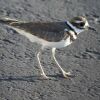
On #1 is the amazing Killdeer! This lovely bird has the most beautiful eyes you’ll ever come across. And although it’s a shorebird, you don’t need to go to the coast to see it. They are quite fond of all types of landscapes, ranging from open fields and pastures to even areas beside the water. Since they don’t shy away from people, you can find them even on golf courses.
As for me, I didn’t feel the need to set up a bird feeder to attract a killdeer. That’s because my backyard has grazed fields, with slight cultivation as well. And that’s what these birds absolutely love - you’ll find them openly feeding on various types of insects and even some seeds. Their style is quite charming too! You can see them running a few steps and then coming to a sudden halt.
Like their name, their call is also shrilling. Their song also goes like ‘dee-dee-dee’. So make sure you’re listening to it well! And there’s one more fascinating fact about them - they often play out the ‘injured wing’ act. They often do this to keep intruders away from their nest and they’re quite successful at it too!
fun fact
noisy bird nicknames
Killdeers can make quite a lot of noise! This is exactly why they have been given nicknames like 'Noisy Plover' or 'Chattering Plover'.
2. Kentucky Warbler
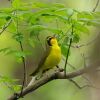
Up next on #2 we have the Kentucky Warbler! This gorgeous black-and-yellow bird is quite the stunner. Go to the eastern forests in the seasons of Spring and Summer if you want to see this bird in action. Look out for its stunning yellow feathers, especially the dash of yellow that surrounds its eyes in the shape of glasses!
You’d need to plan a trip to the forest to see this beautiful bird. I had to do the same because it’s highly unlikely to find these birds on the roadsides or somewhere else. So when I went to the forest, I could see these stunning birds foraging on the ground, mostly going through the dense foliage of leaves. I even spotted one of them picking up an insect from under a leaf.
Your best bet is to find these birds in the early morning hours. During the summer, they’re most likely to sit in places where there’s a bit of light coming in through the forest trees. However, in the winter, these birds stick around a swarm of army ants, mainly to prey upon the insects left over by the ants.
fun fact
just one song
Did you know that the male Kentucky Warbler sings only one song his whole life? It doesn't pick up songs from other birds and doesn't have variations either.
3. King Rail
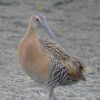
On #3 we have King Rail! This bird is quite easy to spot because of its chicken size! It’s easy to find King Rails in areas where there’s a body of water. So lakes and shallow marshes are quite a thing for them.
I myself spotted one trodding in a shallow marsh. It was foraging for aquatic insects, and perhaps some marine plants as well since most of their diet is made of non-vegetarian food. Their favorites are spiders, clams, grasshoppers, and other such insects. Sometimes they forage on the ground as well, or at least when they find something heavy in the waters, they drag it out of the water and bring it to the land.
Also pay attention to their clattering calls!
fun fact
the male presents food to the female
The male King Rail catches plenty of food for himself and his female counterpart. He gives the majority of it to his partner and keeps the remaining for himself.
4. King Eider
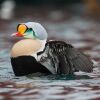
Next on #4 we have the King Eider. It’s a type of waterfowl and both the male and female have unique colors to their feathers.
The best way to find this bird is to plan a trip to the Arctic. But if that’s difficult for you, I got the chance to see the King Eider along the coastlines in the winter. The Great Lakes and Southern Alaska are great places to find large flocks of King Eiders. When I saw them at the Great Lakes for the first time, I was in awe of how different the male and female birds looked but it’s easy to spot what makes them unique though.
For male King Eiders, you’ll find a dash of green on their cheeks, black and white feathers, accompanied by a crown that’s pearl blue in color. On the other hand, the female’s body is black and rusty brown.
Another fascinating fact about these birds is that they can dive as deep as 150 feet to forage for mollusks and other aquatic creatures. They sometimes swim just on the surface and at times, eat plants as well.
fun fact
Migration
These birds can migrate in a variety of conditions. Whether it's in broad daylight or pitch darkness, or even in harsh weather conditions like in a fog.
5. Kirtland’s Warbler
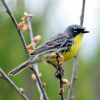
Look who we have on #5 - it’s the Kirtland’s Warbler!
This bird is very rare in North America. I saw one of these precious birds foraging in the lower parts of a tree. in a scrubland. While pines and oaks are their favorite, you can also see them foraging for insects on the ground. I was able to spot it easily by the contrast of its bright yellow feathers and toned-down grey ones. You can also find these birds easily in Ohio and the Bahamas. The younger and greener the forest, the better the chances!
fun fact
females are selective
Male Kirtland Warblers are usually more flexible when it comes to deciding habitats. So the best spot in the forest is more likely to be covered with females rather than males.
6. Kalij Pheasant
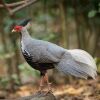
On #6 we have the amazing Kalij Pheasant! At first glance, it may look like a smaller version of a peacock.
I was able to see this wonderful bird on my trip to the Hawaiian Islands. The males are slightly taller compared to the females. Another difference is the color of their feathers. You can see the males having a bluish-black body, whereas the females have a brownish tone. Your best bet is to find them in the depths of the forests or where amongst thick bushes, shrubs, and trees.
fun fact
close relationship
Did you know that the Kalij pheasant and the silver pheasant are closely related? Grey legs are one of the common features of both species!
7. Kittlitz’s Murrelet

On second last is the Kittlitz’s Murrelet!
I was able to see this lovely bird along the shores of Alaska. It loves to forage fishes and other marine creatures, especially in shallow and cold waters. The Kittlitz’s Murrelet I saw also had a golden tint to its body, even though it is covered in grey and white feathers. Another good place to find these birds is on Kodiak Island, which is on the Eastern side of Glacier Bay. Also keep an eye out for their nests, which are typically built on slopes with a bit of vegetation.
fun fact
Did you know?
Did you know that Kittlitz's Murrelet belongs to the family of puffins, auks, and murres? It's no wonder from the similar look of their bodies!
8. Kauai Elepaio
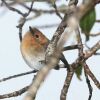
On the very end of this list, we have the Kauai Elepaio! This tiny flycatcher caught my eye with its gray-brown feathers.
Although its numbers have decreased by half, you can find easily find it on Kauai, an island in Hawaii. I was lucky enough to witness both an adult and young Kauai Elepaio. And what surprised me was that their feathers were different in color. The younger bird had a red-brown body, whereas the adult had a bit of white along with grey feathers on its back. You can find them hopping on the branches of trees. They love to forage on all types of insects, even in heaps and piles of leaves.
fun fact
breeding season
Did you know that the breeding season for the Kauai Elepaio can depend on rainfall as well? However, the typical season is between February and June.
Conclusion
So which of the above 8 birds have you seen before? Perhaps you’ve seen the Killdeer before since it’s the most common one. But if you want to look for the Kauai Elepaio, you’ll have to prepare for a trip to Hawaii for sure. Keep our birdwatching tips in mind if you haven’t come across any of them! Also, if you want to learn more about the most common birds in the USA and Canada, read this post on the ones starting with the letter L!

By David A. Swanson
Bird Watching USA
My name is David and I'm the the founder of Bird Watching USA! I started Bird Watching with My father-in-law many years ago, and I've become an addict to watching these beautiful creatures. I've learnt so much over about bird watching over the years that I want to share with the world everything I know about them!

David A. Swanson
Bird Watching USA
My name is David and I'm the the founder of Bird Watching USA! I started Bird Watching with My father-in-law many years ago, and I've become an addict to watching these beautiful creatures. I've learnt so much over about bird watching over the years that I want to share with the world everything I know about them!


